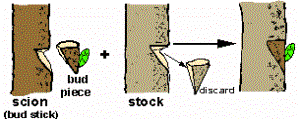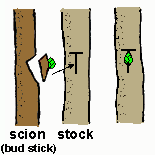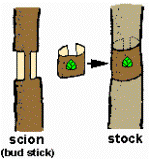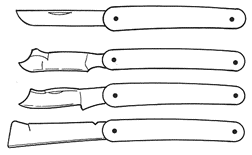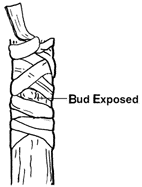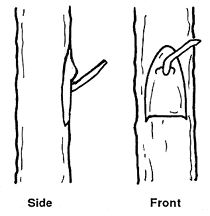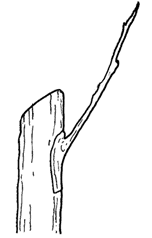Budding Techniques Types T-Budding Chip Budding Patch Budding Forkert Budding Flute Budding Ring or Annular Budding
Budding is a grafting technique in which a single bud from the desired scion is used rather than an entire scion containing many buds. Most budding is done just before or during the growing season. However some species may be budded during the winter while they are dormant. Budding requires the same precautions as grafting. Be sure that the scion and rootstock are compatible, that the scion has mature buds, and that the cambia of the scion and rootstock match. Be especially careful to prevent drying or contamination of grafting materials. With practice, the speed with which the process can be performed and the percentage of successful grafts those that "take" - should equal or surpass those of other grafting techniques used on the same species. Generally, deciduous fruit and shade trees are well suited to budding. 1 Types Used When the Bark is Slipping
Types Used When Bark is not Slipping
Preparing the Rootstock Rootstock can be grown in the field where it will be budded, or dormant liners can be transplanted into the field and then allowed to grow under moderate fertility until they reach the desired 3/16- to 7/16-inch caliper. Since budding is generally done less than 4 inches above the soil surface, leaves and side branches must be removed from this portion of the rootstock to create a clean, smooth working area. To avoid quickly dulling the knife, remove any soil from the rootstock where the cut will be made just before actual budding takes place. The stem can be cleaned by brushing or rubbing it gently by hand or with a piece of soft cloth. 1 Preparing the Budwood Collect scion or budwood early in the day while temperatures are cool and the plants are still fully turgid. The best vegetative buds usually come from the inside canopy of the tree on the current season's growth. Mature buds are most desirable; discard terminal and younger buds because they are often not mature. To keep budwood from drying out, getting hot, or freezing (depending on the season), place it into plastic bags or wrap it in moist burlap as it is collected. Then move to a shaded or sheltered area to prepare the buds. Place budwood of only one variety in each labeled bag. Budsticks are usually prepared in a cool, shaded area. Remove the leaves but keep the petioles (leaf stem) intact to serve as handles when inserting a bud into the rootstock. Then cut the sticks to a convenient length, leaving three to six buds per stick. Budsticks that will not be used immediately should be bundled, labeled, and stored in moisture-retaining containers such as plastic bags or waxed cardboard boxes and kept cool (32o to 45oF). The longer budwood is stored, the less likely it is to "take." Generally, budwood stored for more than a few days should be discarded. When budwood is taken to the field, equal precautions against drying should be taken. Storing budwood in a picnic cooler with ice will help keep it cool and moist. Individual bundles of scions carried by budders are often wrapped in moist burlap or kept in dark (not clear) plastic. 1 T-Budding T-budding must be one when the bark will "slip." Slipping means that, when cut, the bark easily lifts or peels in one uniform layer from the underlying wood without tearing. The exact time when this condition occurs depends on soil moisture, temperature, and time of year. It varies with species and variety. Dry or excessively hot or cold weather can shorten the period when bark slips. Irrigation can be valuable in extending the T-budding season. Since budding is usually done during the warm summer months, two other precautions are commonly taken to ensure success. First, buds should not be added when the air temperature exceeds 90oF. Second, buds should be inserted on the cooler north or east sides of stems. 1 Preparing the Stock Budding knives usually have a curved tip (Fig. 4), making it easier to cut a T-shaped slit. First, insert the point of the knife and use a single motion to cut the top of the T. Then without removing the point of the knife, twist it perpendicularly to the original cut and rock the blade horizontally down the stem to make the vertical slit of the T. If bark is slipping properly, a slight twist of the knife at the end of this cut will pop open the flaps of the cut and make it easier to insert the bud. In practice, the top of the T is usually slanted slightly (Fig. 5). This same type of cut can be made using two separate strokes, one vertical and one horizontal, and then using the back of the budding knife tip to pry up the flaps slightly. Although much slower, this technique may be easier. 1
Removing Buds from the Budstick The bud to be inserted is often just a shield of bark with a bud attached or a very thin layer of wood with both the bark shield and bud attached (Fig. 6). Various techniques can be used to make these cuts, but the shape of the cut remains the same. Begin the first scion cut about 1/2 inch below the bud and draw the knife upward just under the bark to a point at least 1/4 inch above the bud. Grasp the petiole from the detached leaf between the thumb and forefinger of the free hand. Make the second cut by rotating the knife blade straight across the horizontal axis of the budstick and about 1/4 inch above the desired bud. This cut should be deep enough to remove the bud, its shield of bark, and a thin sliver of wood. A variation often used with is to slant the first upward cut so that it goes about halfway through the budstick. Then make the top cut and bend the budstick by applying gentle but constant finger pressure behind the bud. The bark should lift and peel off to the side, yielding bark and bud but no wood. 1 Caution: Straight lifting rather than the sideward motion will separate the bud from the bark rather than keeping it intact. Shields removed this way are useless! The cut surface of the rootstock and bud must stay clean. Do not touch these parts with your fingers. Also, do not set buds down or put them in your mouth. 1
Inserting the Bud Insert the bud shield into the T flaps of the stock and slide it down to ensure that it makes intimate contact with the rootstock (Fig. 7). 1
Securing the Bud Pull the cut together by winding a 4- or 5-inch long budding rubber around the stem to hold the flaps tightly over the bud shield and prevent drying (Fig. 8). Secure the budding rubber by overlapping all windings and tucking the end under the last turn. Do not cover the bud. 1
Further Reading Home Fruit Production-T-Budding Citrus, Aggie Horticulture® publication Chip Budding Chip budding is a technique that may be used whenever mature buds are available. Because the bark does not have to "slip," the chip-budding season is longer than the T-budding season. Species whose bark does not slip easily without tearing may be propagated more successfully by chip budding than by T-budding. 1 Preparing the Stock and the Scion Bud Although all the basics in handling budwood and stock are the same for chip budding and T budding, the cuts made in chip budding differ radically. The first cut on both stock and scion is made at a 45o to 60o downward angle to a depth of about 1/8 inch (Fig. 9). After making this cut on a smooth part of the rootstock, start the second cut about 3/4 inch higher and draw the knife down to meet the first cut. (The exact spacing between the cuts varies with species and the size of the buds.) Then remove the chip. 1
Cuts on both the scion (to remove the bud) and the rootstock (to insert the bud) should be exactly the same (Fig. 10). Although the exact location is not essential, the bud is usually positioned one-third of the way down from the beginning of the cut. If the bud shield is significantly narrower than the rootstock cut, line up one side exactly. 1
Securing the Bud Wrapping is extremely important in chip budding. If all exposed edges of the cut are not covered, the bud will dry out before it can take. Chip budding has become more popular over the past 5 years because of the availability of thin (2-mil) polyethylene tape as a wrapping material. This tape is wrapped to overlap all of the injury, including the bud (Fig. 11), and forms a miniature plastic greenhouse over the healing graft. 1
Budding Aftercare Although budding rubbers and polyethylene tape reportedly decompose and need not be removed, studies show that unless they are taken off, binding or girdling of fast-growing plants may occur within a month. On species budded in early summer, it may be desirable for the buds to break and grow during the same season. In this case, either remove the stock tops entirely or break them over within a few weeks of budding to encourage the scion buds to break. Once the buds have broken, completely remove the stock above the bud or keep a few leaves intact but remove the terminals, depending upon the species. For plants budded in late summer, remove the tops just before growth starts the following spring. A slanting cut away from the bud is preferred (Fig. 12). If possible, set up stakes or other devices to insure that straight growth will occur before the buds break. Straight shoots, however, are so essential to the growth of high-quality grafted and budded stock that stakes should be set as they are needed. To insure a top-quality plant, it is essential to remove unwanted sprouts. These sprouts should be "rubbed" off as soon as they are visible so that they do not reduce the growth and quality of the budded stock. If they are removed regularly and early, large scars or "doglegs" can be avoided. 1
Summary Grafting and budding techniques combine the science and the art of horticulture. The scientific aspects include comparability, timing, disease and insect resistance, drought, tolerance, and hardiness. Information on these topics may be found in have a broad working knowledge of a variety of texts and pamphlets. Acquiring practical skills in the art of grafting and budding, on the other hand, requires hours and even years of practice to perfect. Usually the careful supervision of a trained propagator is required for the serious student of budding and grafting to learn this art. From this publication it should be clear that many types of budding and grafting techniques are available. Individual propagators usually have a broad working knowledge of all of these techniques but a high degree of skill in only two or three. These budding and grafting techniques can be used successfully, especially on a commercial basis, to propagate clonal plant materials. In fact, perpetuating many of our horticultural clones depends on the successful application of these techniques. 1 Further Reading Chip Budding: An Old Grafting Technique for Woody Plants With Rediscovered Advantages for Nebraska, University of Nebraska Lincoln Extension pdf Chip Bud Grafting in Washington State Vineryards, Washington State University Extension pdf Patch Budding Patch Budding – probably the simplest to perform among the various methods of budding due to ease in removing or preparing rectangular patches of bark. It is widely used in plants with thick bark that can be easily separated from the wood. The method involves the complete removal of a rectangle-shaped patch of bark with the longer sides parallel to the axis of the stem of the rootstock. It is then replaced with a bud patch of the same size from a budstick. The patch of bud is cut from both the rootstock and the budstick by two parallel horizontal cuts either with one stroke of a double-bladed knife or two strokes when using a single-bladed knife. With vertical stroke of a knife, both horizontal cuts are connected at each side. The bud patch is carefully removed intact and inserted into the rootstock. 2 Further Reading Patch Budding: a Convenient Method for Top-Working Olives, University of California ANRC pdf Patch Budding Pecans, University of Oklahoma Cooperative Exention pdf Forkert Budding A form of patch budding in which the patch of bark in the rootstock is retained. Incisions are made on the bark of the rootstock in the shape of “Π” and pulled downward as a flap which is then used to cover the inserted bud patch. This flap is later removed to expose the bud. Both Patch and Forkert methods of budding follows the same procedure in the preparation of a bud patch. 2 Flute Budding Similar to patch budding but the patch of bark that is removed from the stem of a rootstock almost completely encircles it except that there remains a narrow strip of bark (~1/8 the rootstock circumference) that connects the upper and the lower parts of the rootstock. The bud patch is prepared by two horizontal cuts about 2.5 cm apart (the same length as in the rootstock) in circular motion around the stem. The two cuts are then connected by a vertical cut and the patch of bark is separated intact from the wood. The circumference of the bud patch may be shortened by a vertical cut to fit into the rootstock. 2 Ring or Annular Budding 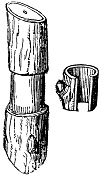 Fig. 13 A method of budding the procedure of which is closely similar to the Flute budding technique. It involves the removal of a complete ring of bark from the rootstock without leaving a strip of bark that connects the upper and lower parts of the rootstock. As a result, a portion of the stem is girdled as if in preparation for marcotting. It is then replaced with a complete ring of bark with the same size from the budstick. Compared to the other methods of budding, it is rarely used because should bud union fail, the upper part of the rootstock above the ring may die. 2 Further Reading Plant Propagation by Grafting and Budding, Pacific Northwest Extension publication pdf Budding and Grafting Citrus and Avocados in the Home Garden, University of California Division of Agriculture and Natural Resources pdf Propagating Fruit Trees by Budding, Oklahoma State University, Cooperative Extension pdf Back to Grafting Techniques Page Propagation Page |
||||||||||||||||||||||||||
| Bibliography 1 Bilderback, Ted, R. E. Bir, and T. G. Ranney. "Grafting and Budding Nursery Crop Plants." North Carolina Cooperative Extension Service, North Carolina State University, College of Agriculture and Life Sciences. June 30, 2014. ces.ncsu.edu/grafting-and-budding-nursery-crop-plants. Accessed 16 May 2018. 2 Bareja, Ben G. "Various Methods of Budding Described." cropsreview.com. Nov. 2011. Accessed 20 May 2014. Photographs Fig. 1,2,3 Reed, D. W. "Budding Techniques." agrilifeextension.tamu.edu. Web. 17 May 2014. Fig. 4,5,6,7,8,9,10,11,12 "Grafting and Budding Nursery Crop Plants." North Carolina Cooperative Extension Service, North Carolina State University, College of Agriculture and Life Sciences, 2014. ces.ncsu.edu/grafting-and-budding-nursery-crop-plants. Accessed 16 May 2018. Fig. 13 "Ring Budding." The Project Gutenberg EBook of American Pomology Apples, 1867, Release Date: Oct. 2, 2011 [EBook #37596], www.gutenberg.org/files/37596/37596-h/37596-h.htm. Accessed 16 May 2018. Published Feb. 2014 LR. Last update 26 July 2018 LR |
||||||||||||||||||||||||||
